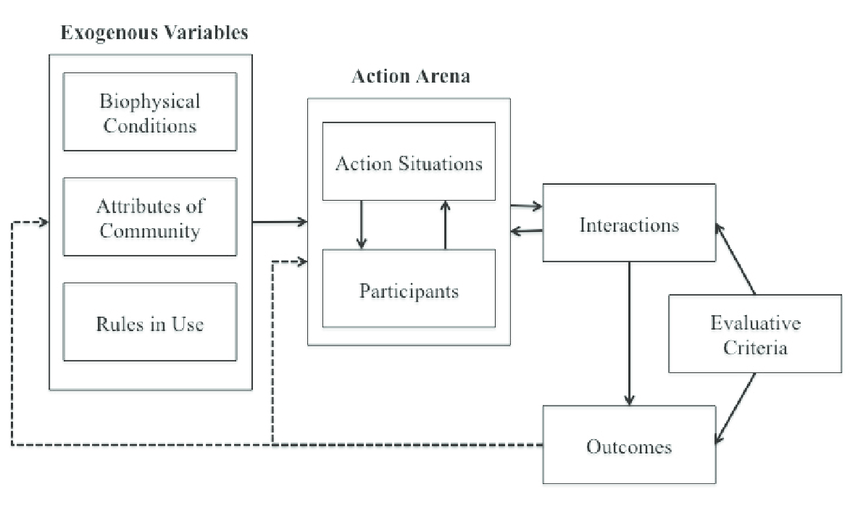- Facebook273
- Twitter2
- Total 276
If you want to analyze an institution–whether it’s the local police department, marriage, or Facebook–an excellent guide is the Institutional Analysis and Development (IAD) Framework developed by Elinor Ostrom and colleagues, which is an encapsulation of the lifetime of work for which Ostrom won the Nobel Prize. It is shown below in a graphical form, and a very helpful, concise guide is McGinnis 2011.

I would divide the analysis into the following 23 questions. These questions basically cover the same issues as in the diagram above, working from left to right, but they don’t match up precisely because I draw on my own idiosyncratic influences.
- What is the institution? What is its name? How would you define it uniquely, and which people, resources, locations, etc. does it involve?
- What problem or set of problems interests you about it? This problem may be a failure (the institution doesn’t yield the intended results) or an injustice (it has bad results), or it could be the intellectual problem posed by its success: why does this institution work and can we replicate it?
- What other institutions are closely related to it, and how?
- Which institutional form(s) does it reflect, e.g., a government, a firm, a market, a network, an association, a community?
- What are important relevant biophysical conditions? What natural resources does it use, and which natural processes come into play? What characteristics of these resources and processes are relevant to the institution: e.g., scarcity, fragility, adaptability, ability to reproduce and grow, interdependence, tendency to move?
- What are important technological conditions, where “technology” means the relevant affordances and limitations that have been created–or will predictably be created–by human beings?
- What cultural meanings (in the sense of Geertz 1973) are involved? Are these meanings shared or disputed?
- To what extent can we detect wholes, rhythms, hierarchies, and networks in the institution (C. Levine 2015)? How do these forms interrelate?
- What official, formal, usually written rules govern the institution? What are its rules-in-use? (These may diverge from the official rules.)
- Are the rules grounded in phenomena beyond the institution? For instance, an institution might use a currency whose value is determined by other institutions. Tufts runs on an academic calendar related to the solar calendar, which is grounded in the motion of the earth. (Grounding is different from causation.)
- What goods are relevant? Who has which kinds of ownership over which goods? Are the goods subtractable? Are they excludable?
- Who are the relevant actors?
- What choices confront each actor? What does each actor know about the available choices?
- What does each actor value, and why?
- Under what conditions do the actors choose (e.g., with or without discussion, once or repeatedly, simultaneously or in turn, with or without knowledge of what the others are choosing)?
- What are the consequences of the most important or most likely combinations of choices made by all the actors?
- Are these consequences desired by the actors?
- Are these outcomes desired by people who are not among the actors?
- Are the outcomes fair or just by various normative criteria?
- Are they sustainable–meaning a) literally repeatable many times, and/or b) good for nature?
- How do the outcomes affect the issues raised in questions 1-15? In other words, do the outcomes of the institution change the institution itself, in a feedback loop?
- What deliberate changes in institutional forms (4), technologies (6), meanings (7), rules (9-10), or values (13) would produce preferable outcomes according to the criteria raised in questions 17-19? (I focus on 4, 6, 9-10, and 13 on the ground that these are the factors we can most readily change. Factors like the biophysical conditions and the relevance of other institutions are harder to influence.)
- How can we go about altering the institution in the light of 21?
Geertz, Clifford (1973) Thick description: Toward an interpretive theory of culture. The interpretation of cultures: Selected essays (pp. 3-30). New York, NY: Basic
Levine, C. (2015). Forms: Whole, rhythm, hierarchy, network. Princeton University Press.
Mcginnis, Michael. (2011). An Introduction to IAD and the Language of the Ostrom Workshop: A Simple Guide to a Complex Framework. Policy Studies Journal. 39. 169 – 183. 10.1111/j.1541-0072.2010.00401.x.
See also: insights on police reform from Elinor Ostrom and social choice theory; Elinor Ostrom, 1933-2012; why I still believe in institutions; should all institutions be democratic?; what defines an organization?; and against methodological individualism.
